Causes of the Extremely Heavy Rainfall Event in Libya in September 2023
Abstract
1. Introduction
2. Data and Methods
2.1. Data
2.2. Methods
3. Results
3.1. Characteristics of the Spatial and Temporal Distribution of Precipitation
3.2. Synoptic Systems and Circulation Characteristics
3.2.1. Circulation Characteristics at 500 hPa in the Mid-Troposphere
3.2.2. Circulation Characteristics at 850 hPa in the Lower Troposphere
3.3. Causes of Extreme Precipitation
3.3.1. Moisture Conditions
3.3.2. Dynamic Conditions
3.4. Impact of Topography and SST Anomalies
3.4.1. Impact of Topography
3.4.2. Impact of SST
4. Discussion and Conclusions
Author Contributions
Funding
Data Availability Statement
Acknowledgments
Conflicts of Interest
Abbreviations
| ECMWF | European Centre for Medium-Range Weather Forecasts |
| OISST V2 | Optimum Interpolation Sea Surface Temperature Version 2 |
| IMERG | Integrated Multi-satellitE Retrievals for Global |
| GPM | Global Precipitation Measurement |
| TRMM | Tropical Rainfall Measuring Mission |
| FNL | Final Operational Global Analysis |
| NCAR | National Center for Atmospheric Research |
| VWS | vertical wind shear |
| CAPE | convective available potential energy |
| CIN | convective inhibition |
| SST | sea surface temperature |
References
- Seager, R.; Murtugudde, R.; Naik, N.; Clement, A.; Gordon, N.; Miller, J. Air–Sea Interaction and the Seasonal Cycle of the Subtropical Anticyclones. J. Clim. 2003, 16, 1948–1996. [Google Scholar] [CrossRef]
- Campins, J.; Genovés, A.; Picornell, M.Á.; Jansà, A. Climatology of Mediterranean cyclones using the ERA-40 dataset. Int. J. Climatol. 2011, 31, 1596–1614. [Google Scholar] [CrossRef]
- Zhang, W.; Villarini, G.; Scoccimarro, E.; Napolitano, F. Examining the precipitation associated with medicanes in the high-resolution ERA-5 reanalysis data. Int. J. Climatol. 2021, 41, E126–E132. [Google Scholar] [CrossRef]
- Zelenakova, M.; Purcz, P.; Gargar, I.; Hlavatá, H. Comparison of precipitation trends in Libya and Slovakia. WIT Trans. Ecol. Environ. 2013, 172, 365–374. [Google Scholar]
- Rustemeier, E.; Ziese, M.; Meyer-Christoffer, A.; Schneider, U.; Finger, P.; Becker, A. Uncertainty Assessment of the ERA-20C Reanalysis Based on the Monthly In Situ Precipitation Analysis of the Global Precipitation Climatology Centre. J. Hydrometeorol. 2019, 20, 231–250. [Google Scholar] [CrossRef]
- Zittis, G. Observed rainfall trends and precipitation uncertainty in the vicinity of the Mediterranean, Middle East and North Africa. Theor. Appl. Climatol. 2018, 134, 1207–1230. [Google Scholar] [CrossRef]
- Caloiero, T.; Veltri, S.; Caloiero, P.; Frustaci, F. Drought Analysis in Europe and in the Mediterranean Basin Using the Standardized Precipitation Index. Water 2018, 10, 1043. [Google Scholar] [CrossRef]
- Elfadli, K.I.; Wahab, M.M.A.; Khalil, A.A.E.L. Chapter 4—Impacts of climate change on drought in Libya. In Hydroclimatic Extremes in the Middle East and North Africa; Ahmed, M., Kenawy, E., et al., Eds.; Elsevier: Amsterdam, The Netherlands, 2024; pp. 49–74. [Google Scholar]
- Seager, R.; Osborn, T.J.; Kushnir, Y.; Simpson, I.R.; Nakamura, J.; Liu, H. Climate Variability and Change of Mediterranean-Type Climates. J. Clim. 2019, 32, 2887–2915. [Google Scholar] [CrossRef]
- WMO. Storm Daniel Leads to Extreme Rain and Floods in Mediterranean, Heavy Loss of Life in Libya; WMO: Geneva, Switzerland, 2023. [Google Scholar]
- Argüeso, D.; Marcos, M.; Amores, A. Storm Daniel fueled by anomalously high sea surface temperatures in the Mediterranean. npj Clim. Atmos. Sci. 2024, 7, 307. [Google Scholar] [CrossRef]
- Wehner, M.F. Predicted twenty-first-century changes in seasonal extreme precipitation events in the parallel climate model. J. Clim. 2004, 17, 4281–4290. [Google Scholar] [CrossRef]
- Groisman, P.Y.; Knight, R.W. Prolonged Dry Episodes over the Conterminous United States: New Tendencies Emerging during the Last 40 Years. J. Clim. 2008, 21, 1850–1862. [Google Scholar] [CrossRef]
- Trenberth, K.E. Changes in precipitation with climate change. Clim. Res. 2011, 47, 123. [Google Scholar] [CrossRef]
- Giorgi, F.; Lionello, P. Climate change projections for the Mediterranean region. Glob. Planet. Change 2008, 63, 90–104. [Google Scholar] [CrossRef]
- Lebeaupin, C.; Ducrocq, V.; Giordani, H. Sensitivity of torrential rain events to the sea surface temperature based on high-resolution numerical forecasts. J. Geophys. Res. 2006, 111, D12110. [Google Scholar] [CrossRef]
- Jansa, A.; Alpert, P.; Arbogast, P.; Buzzi, A.; Ivancan-Picek, B.; Kotroni, V.; Llasat, M.C.; Ramis, C.; Richard, E.; Romero, R.; et al. MEDEX: A general overview. Nat. Hazards Earth Syst. Sci. 2014, 14, 1965–1984. [Google Scholar] [CrossRef]
- Field, P.R.; Wood, R. Precipitation and cloud structure in midlatitude cyclones. J. Clim. 2007, 20, 233–254. [Google Scholar] [CrossRef]
- Rappaport, E.N. Loss of life in the United States associated with recent Atlantic tropical cyclones. Bull. Am. Meteorol. Soc. 2002, 81, 2065–2073. [Google Scholar] [CrossRef]
- Ulbrich, U.; Brücher, T.; Fink, A.H.; Leckebusch, G.C.; Krüger, A.; Pinto, J.G. The central European floods of August 2002: Part 2—Synoptic causes and considerations with respect to climatic change. Weather 2003, 58, 434–442. [Google Scholar] [CrossRef]
- Lin, Y.; Chiao, S.; Wang, T.; Kaplan, M.L.; Weglarz, R.P. Some Common Ingredients for Heavy Orographic Rainfall. Weather. Forecast. 2001, 16, 633–660. [Google Scholar] [CrossRef]
- Ogura, Y.; Yoshizaki, M. Numerical study of orographic–convective precipitation over the Eastern Arabian Sea and the Ghat Mountains during the summer monsoon. J. Atmos. Sci. 1988, 45, 2097–2122. [Google Scholar] [CrossRef]
- Houze, R.A., Jr. Orographic effects on precipitating clouds. Rev. Geophys. 2012, 50, RG1001. [Google Scholar] [CrossRef]
- Buzzi, A.; Tartaglione, N.; Malguzzi, P. Numerical simulations of the 1994 Piemont flood: Role of orography and moist processes. Mon. Weather. Rev. 1998, 126, 2369–2383. [Google Scholar] [CrossRef]
- Avgoustoglou, E.; Muskatel, H.B.; Khain, P.; Levi, Y. The Performance of ICON (Icosahedral Non-Hydrostatic) Regional Model for Storm Daniel with an Emphasis on Precipitation Evaluation over Greece. Atmosphere 2025, 16, 1043. [Google Scholar] [CrossRef]
- Ernst, J.A.; Matson, M. A Mediterranean tropical storm. Weather 1983, 38, 332–337. [Google Scholar] [CrossRef]
- Rasmussen, E.; Zick, C. A subsynoptic vortex over the Mediterranean with some resemblance to polar lows. Tellus A Dyn. Meteorol. Oceanogr. 1987, 39, 408–425. [Google Scholar] [CrossRef]
- Tous, M.; Romero, R. Meteorological environments associated with medicane development. Int. J. Climatol. 2013, 33, 1–14. [Google Scholar] [CrossRef]
- Miglietta, M.M.; Laviola, S.; Malvaldi, A.; Conte, D.; Levizzani, V.; Price, C. Analysis of tropical-like cyclones over the Mediterranean Sea through a combined modelling and satellite approach. Geophys. Res. Lett. 2013, 40, 2400–2405. [Google Scholar] [CrossRef]
- Miglietta, M.M.; Flaounas, E.; González-Alemán, J.J. Defining Medicanes: Bridging the Knowledge Gap between Tropical and Extratropical Cyclones in the Mediterranean. Bull. Am. Meteorol. Soc. 2025, 106, E1955–E1971. [Google Scholar] [CrossRef]
- Homar, V.; Romero, R.; Stensrud, D.J.; Ramis, C.; Alonso, S. Numerical diagnosis of a small, quasi-tropical cyclone over the western Mediterranean: Dynamical vs. boundary factors. Q. J. R. Meteorol. Soc. 2003, 12, 1469–1490. [Google Scholar] [CrossRef]
- Carrió, D.; Homar, V.; Jansa, A.; Romero, R.; Picornell, M. Tropicalization process of the 7 November 2014 Mediterranean cyclone: Numerical sensitivity study. Atmos. Res. 2017, 197, 300–312. [Google Scholar] [CrossRef]
- Fita, L.; Flaounas, E. Medicanes as subtropical cyclones: The December 2005 case from the perspective of surface pressure tendency diagnostics and atmospheric water budget. Q. J. R. Meteorol. Soc. 2018, 144, 1028–1044. [Google Scholar] [CrossRef]
- Noyelle, R.; Ulbrich, U.; Becker, N.; Meredith, E.P. Assessing the impact of sea surface temperatures on a simulated medicane using ensemble simulations. Nat. Hazards Earth Syst. Sci. 2019, 19, 941–955. [Google Scholar] [CrossRef]
- Davolio, S.; Fera, S.D.; Laviola, S.; Miglietta, M.M.; Levizzani, V. Heavy Precipitation over Italy from the Mediterranean Storm “Vaia” in October 2018: Assessing the Role of an Atmospheric River. Mon. Weather. Rev. 2020, 148, 3571–3588. [Google Scholar] [CrossRef]
- Pantillon, F.; Davolio, S.; Avolio, E.; Calvo-Sancho, C.; Carrió, D.S.; Dafis, S.; Gentile, E.S.; Gonzalez-Aleman, J.J.; Gray, S.; Miglietta, M.M.; et al. The crucial representation of deep convection for the cyclogenesis of Medicane Ianos. Weather. Clim. Dyn. 2024, 5, 1187–1205. [Google Scholar] [CrossRef]
- Hersbach, H.; Bell, B.; Berrisford, P.; Biavati, G.; Horányi, A.; Muñoz Sabater, J.; Nicolas, J.; Peubey, C.; Radu, R.; Rozum, I.; et al. ERA5 Hourly Data on Single/Pressure Levels from 1940 to Present; Copernicus Climate Change Service (C3S) Climate Data Store (CDS): Reading, UK, 2023. [Google Scholar]
- Banzon, V.; Smith, T.M.; Chin, T.M.; Liu, C.; Hankins, W. A long-term record of blended satellite and in situ sea-surface temperature for climate monitoring, modeling and environmental studies. Earth Syst. Sci. Data 2016, 8, 165–176. [Google Scholar] [CrossRef]
- Hou, A.Y.; Kakar, R.K.; Neeck, S.; Azarbarzin, A.A.; Kummerow, C.D.; Kojima, M.; Oki, R.; Nakamura, K.; Iguchi, T. The global precipitation measurement mission. Bull. Am. Meteorol. Soc. 2014, 95, 701–722. [Google Scholar] [CrossRef]
- Palmer, C.K.; Barnes, G.M. The effects of vertical wind shear as diagnosed by the NCEP/NCAR reanalysis data on northeast Pacific hurricane intensit. In Proceedings of the 25th Conference on Hurricanes and Tropical Meteorology, San Diego, CA, USA, 28 April–3 May 2002; pp. 28–29. [Google Scholar]
- Yao, C.; Lou, S.S.; Ye, J.Y. Mesoscale analysis and numerical simulation of a typhoon rainstrom event affected by cold air. Torrential Rain Disasters 2019, 38, 204–211. [Google Scholar]
- Lu, J.L.; Guo, P.W. Impacts of the intrusion intensity of cold air on extratropical transition of Typhoon Krosa. J. Meteorol. Sci. 2012, 32, 355–364. [Google Scholar]
- Dong, M.Y.; Chen, L.S.; Li, Y.; Cheng, Z.Q. Numerical study of cold air impact on rainfall reinforcement associated with Tropical Cyclone Talim (2005): I. Impact of different cold air intensity. J. Trop. Meteorol. 2013, 19, 87–96. [Google Scholar]
- Rodgers, E.B.; Pierce, H.F. Environmental Influence on Typhoon Bobbie’s Precipitation Distribution. J. Appl. Meteorol. Climatol. 1995, 34, 2513–2532. [Google Scholar] [CrossRef]
- Frank, W.M.; Ritchie, E.A. Effects of vertical wind shear on the intensity and structure of numerically simulated hurricanes. Mon. Weather. Rev. 2001, 129, 2249–2269. [Google Scholar] [CrossRef]
- Schumacher, R.S.; Rasmussen, K.L. The formation, character and changing nature of mesoscale convective systems. Nat. Rev. Earth Environ. 2020, 1, 300–314. [Google Scholar] [CrossRef]
- Trenberth, K.E. Atmospheric moisture residence times and cycling: Implications for rainfall rates and climate change. Clim. Change 1998, 39, 667–694. [Google Scholar] [CrossRef]
- Merrill, R.T. Environmental influences on hurricane intensification. J. Atmos. Sci. 1988, 45, 1678–1687. [Google Scholar] [CrossRef]
- Dai, Y.; Majumdar, S.J.; Nolan, D.S. The outflow–rainband relationship induced by environmental flow around tropical cyclones. J. Atmos. Sci. 2019, 76, 1845–1863. [Google Scholar] [CrossRef]
- Wu, F.; Lombardo, K. Investigation of a mesoscale convective system over the eastern United States in future climates. Part II: Storm-scale processes. J. Clim. 2025, 38, 3533–3562. [Google Scholar] [CrossRef]
- Sullivan, S.C.; Vautravers, P.; Beucler, T.; Makgoale, T.; Yin, J. Moisture–precipitation couplings for mesoscale convective systems in tracking data and idealized simulations. J. Atmos. Sci. 2025, 82, 1885–1902. [Google Scholar] [CrossRef]
- Demirdjian, R.; Doyle, J.D.; Finocchio, P.M.; Reynolds, C.A. On the influence of surface latent heat fluxes on idealized extratropical cyclones. J. Atmos. Sci. 2022, 79, 2229–2242. [Google Scholar] [CrossRef]
- Naud, C.M.; Crespo, J.A.; Posselt, D.J.; Booth, J.F. Cloud and precipitation in low-latitude extratropical cyclones conditionally sorted on CYGNSS surface latent and sensible heat fluxes. J. Clim. 2023, 36, 5659–5680. [Google Scholar] [CrossRef]
- Gyakum, J.R.; Danielson, R.E. Analysis of Meteorological Precursors to Ordinary and Explosive Cyclogene-sis in the Western North Pacific. Mon. Weather. Rev. 2000, 128, 851–863. [Google Scholar] [CrossRef]
- Gutiérrez-Fernández, J.; González-Alemán, J.J.; de la Vara, A.; Cabos, W.; Sein, D.V.; Gaertner, M.Á. Impact of ocean–atmosphere coupling on future projection of Medicanes in the Mediterranean sea. Int. J. Climatol. 2021, 41, 2226–2238. [Google Scholar] [CrossRef]
- Toomey, T.; Amores, A.; Marcos, M.; Orfila, A.; Romero, R. Coastal hazards of tropical-like cyclones over the Mediterranean Sea. J. Geophys. Res. Ocean. 2022, 127, e2021JC017964. [Google Scholar] [CrossRef]
- González-Alemán, J.J.; Pascale, S.; Gutierrez-Fernandez, J.; Murakami, H.; Gaertner, M.A.; Vecchi, G.A. Potential increase in hazard from Mediterranean hurricane activity with global warming. Geophys. Res. Lett. 2019, 46, 1754–1764. [Google Scholar] [CrossRef]
- Guo, Y.; Beyerle, U.; Bevacqua, E.; Zscheischler, J.; Suarez-Gutierrez, L.; Mittermeier, M.; Fu, Z.; Fischer, E. European compound flood-heat-flood events associated with Omega patterns cannot be easily reproduced by a fully coupled model. Commun. Earth Environ. 2025, 6, 491. [Google Scholar] [CrossRef]
- Trigo, I.F. Climatology and interannual variability of storm-tracks in the Euro-Atlantic sector: A comparison between ERA-40 and NCEP/NCAR reanalyses. Clim. Dyn. 2006, 26, 127–143. [Google Scholar] [CrossRef]
- Flocas, H.A.; Simmonds, I.; Kouroutzoglou, J.; Keay, K.; Hatzaki, M.; Bricolas, V.; Asimakopoulos, D. On Cyclonic Tracks over the Eastern Mediterranean. J. Clim. 2010, 23, 5243–5257. [Google Scholar] [CrossRef]
- Tilinina, N.; Gulev, S.K.; Rudeva, I.; Koltermann, P. Comparing cyclone life cycle characteristics and their interannual variability in different reanalyses. J. Clim. 2013, 26, 6419–6438. [Google Scholar] [CrossRef]
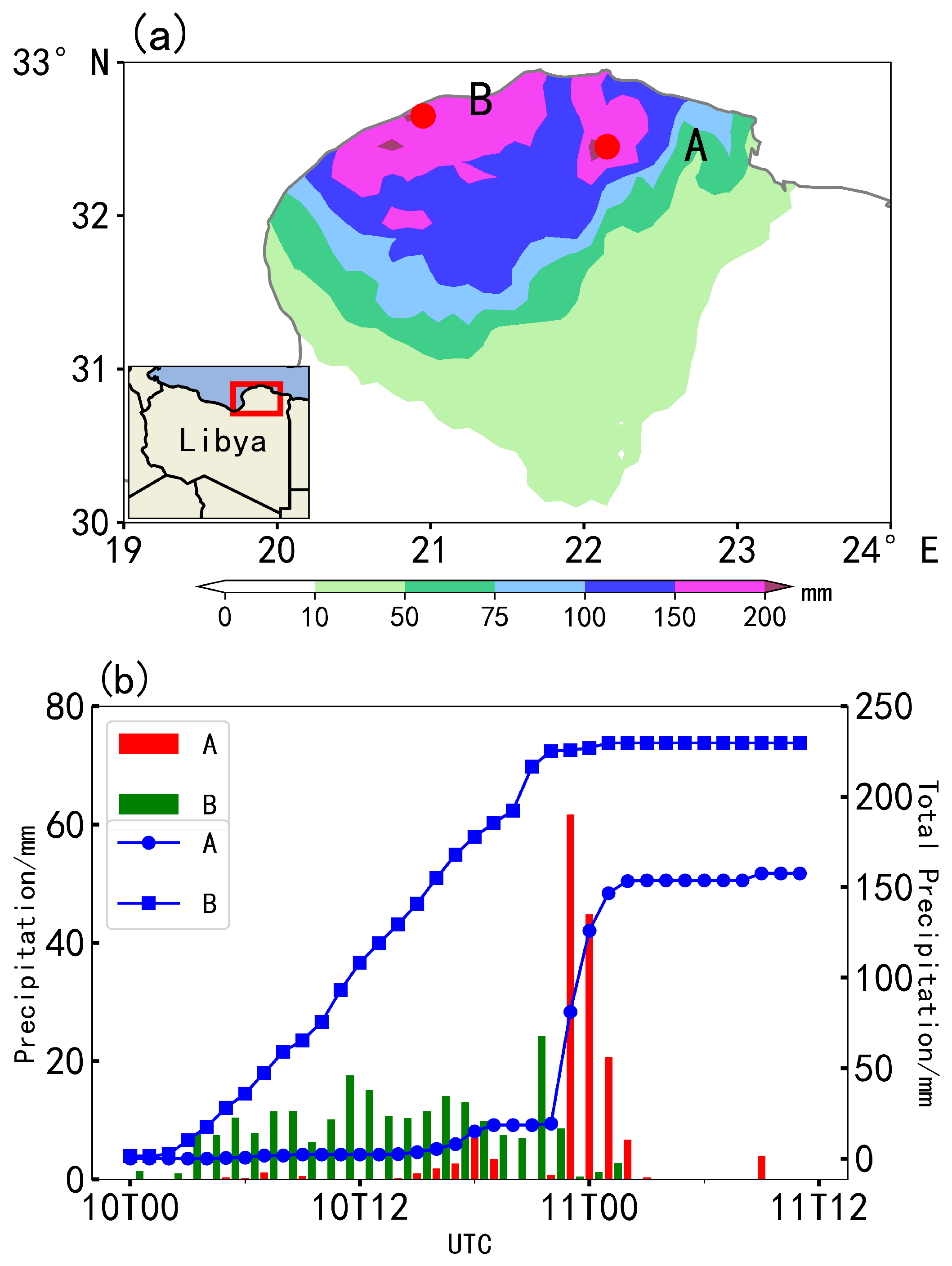



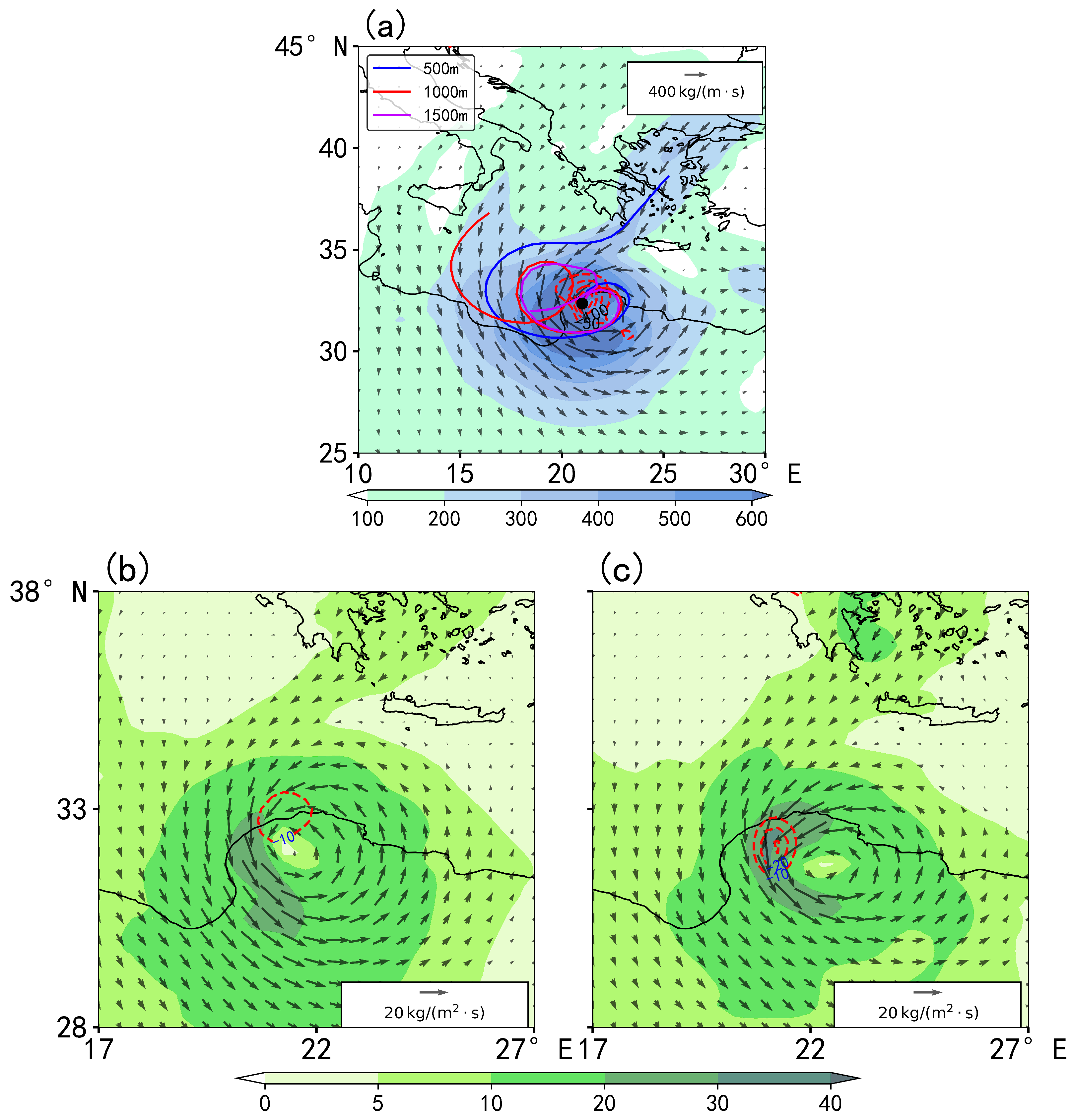
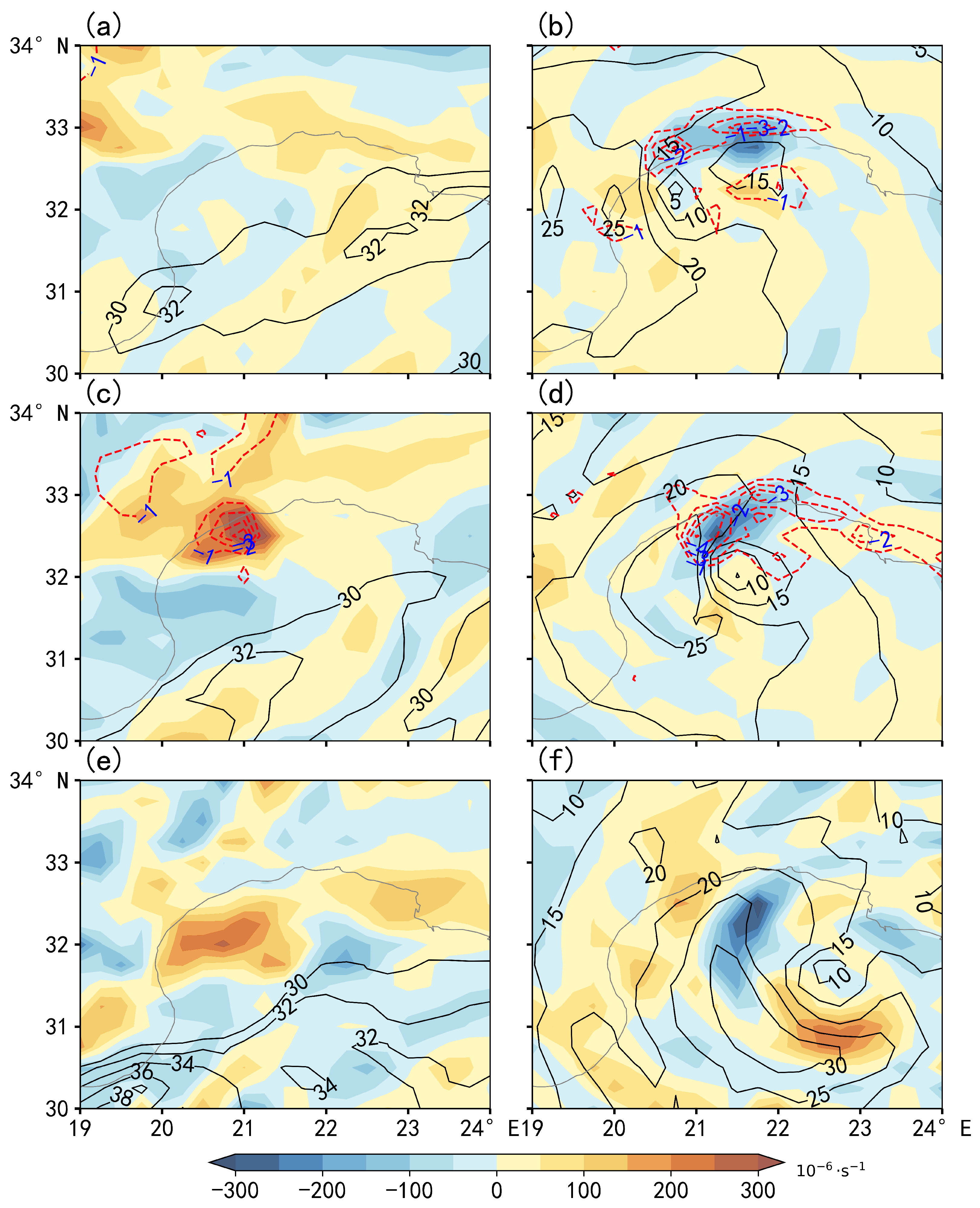
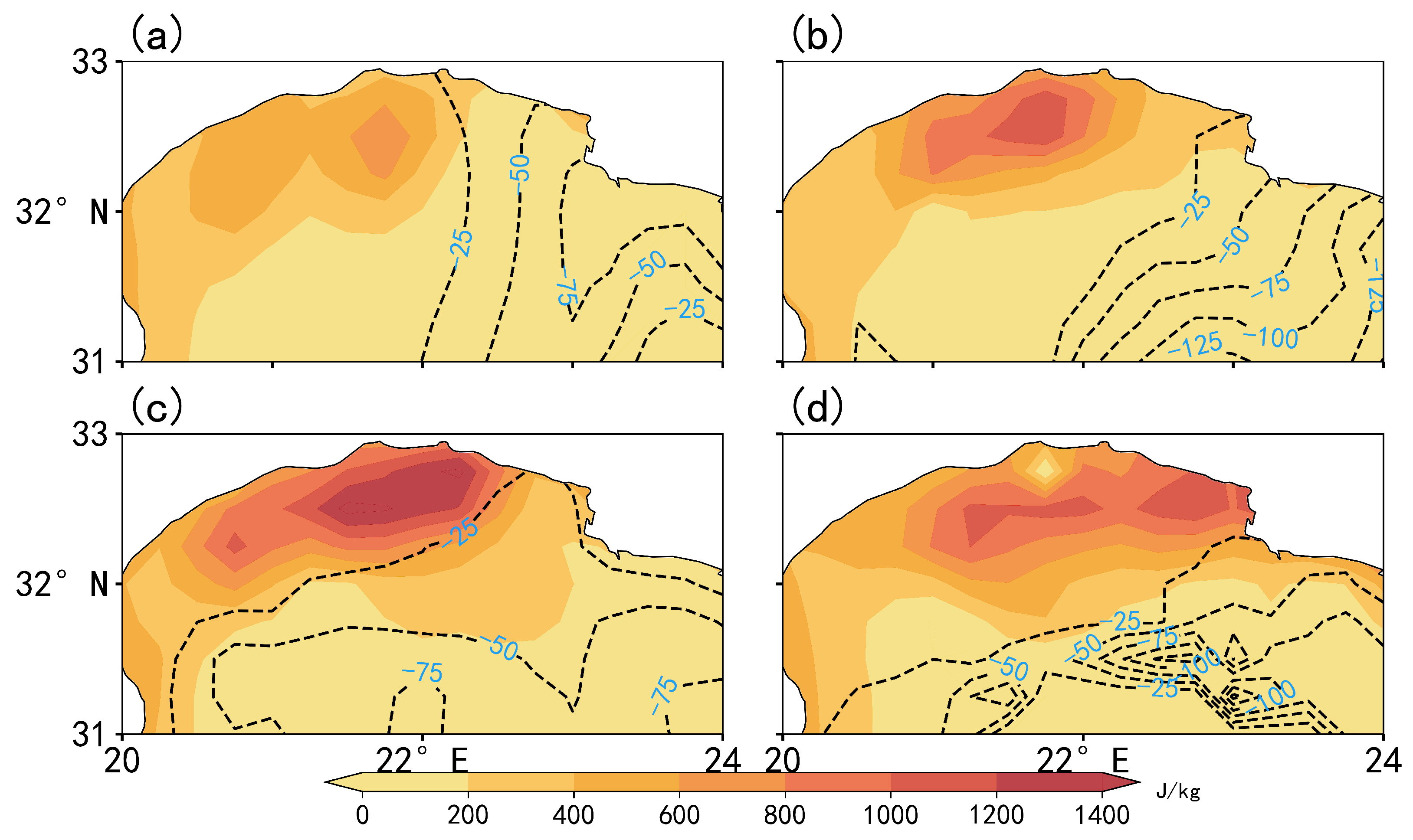


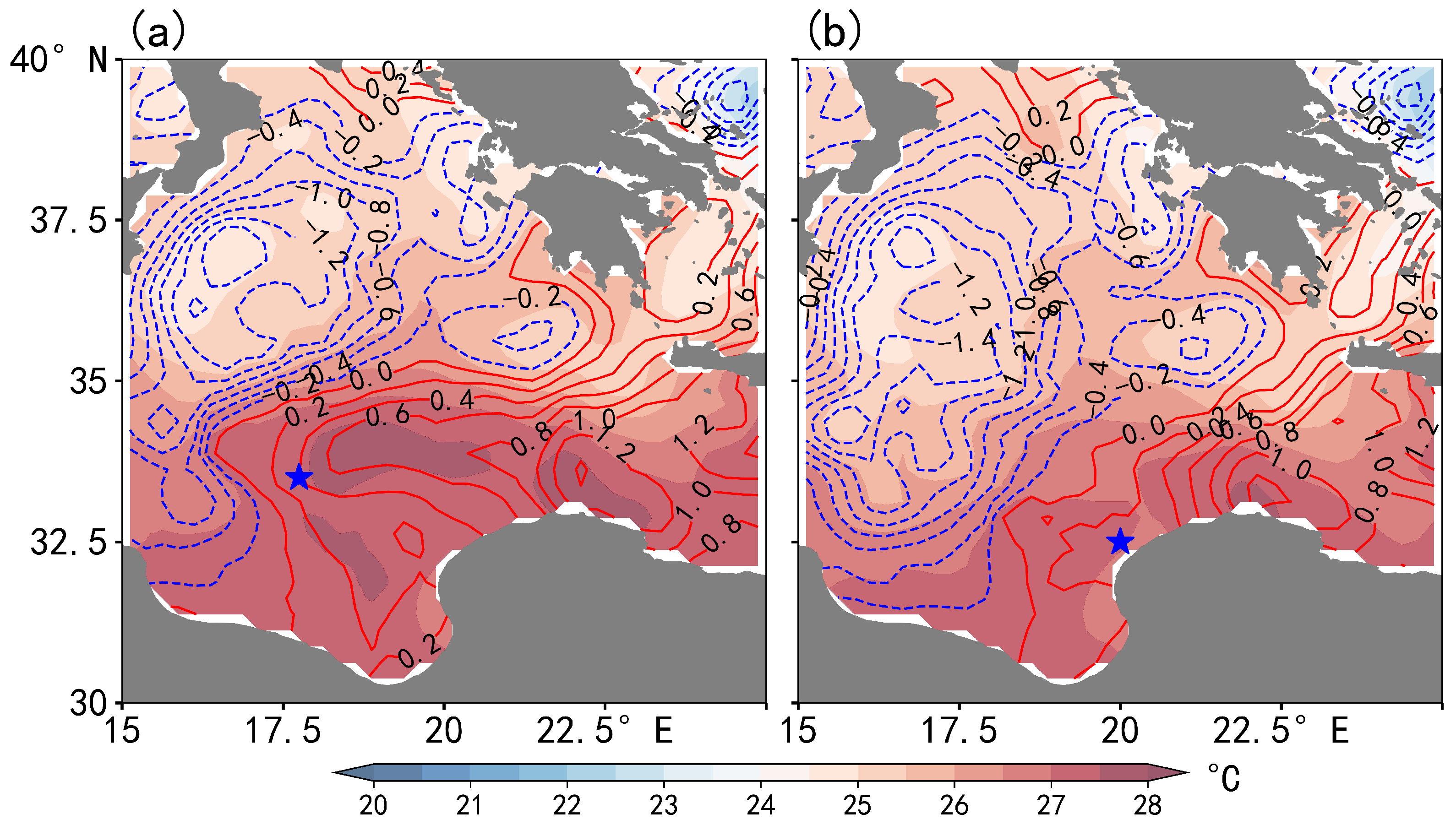
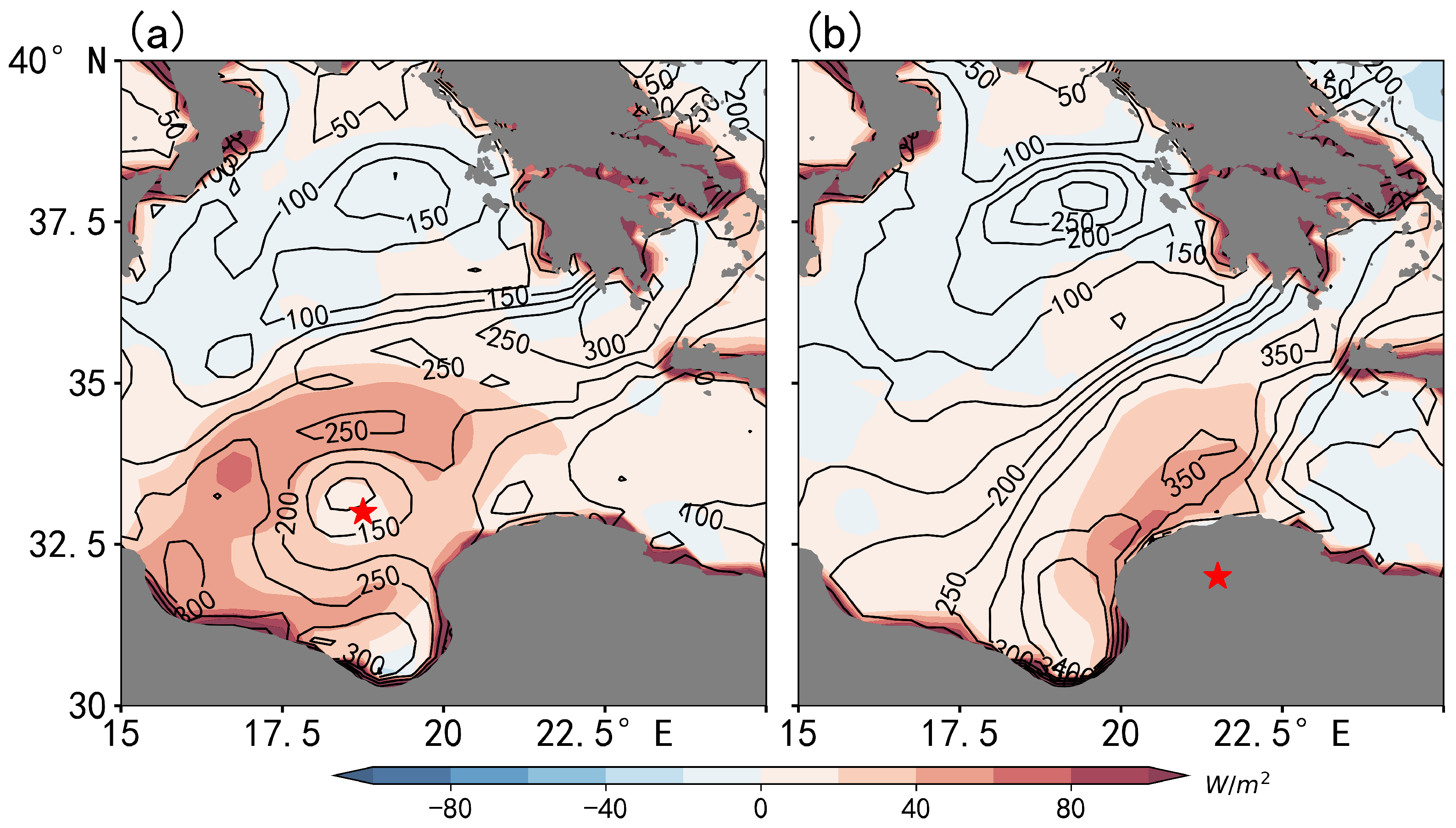

Disclaimer/Publisher’s Note: The statements, opinions and data contained in all publications are solely those of the individual author(s) and contributor(s) and not of MDPI and/or the editor(s). MDPI and/or the editor(s) disclaim responsibility for any injury to people or property resulting from any ideas, methods, instructions or products referred to in the content. |
© 2025 by the authors. Licensee MDPI, Basel, Switzerland. This article is an open access article distributed under the terms and conditions of the Creative Commons Attribution (CC BY) license (https://creativecommons.org/licenses/by/4.0/).
Share and Cite
Zou, Y.; Xu, H.; Guo, X.; Yan, S. Causes of the Extremely Heavy Rainfall Event in Libya in September 2023. Atmosphere 2025, 16, 1259. https://doi.org/10.3390/atmos16111259
Zou Y, Xu H, Guo X, Yan S. Causes of the Extremely Heavy Rainfall Event in Libya in September 2023. Atmosphere. 2025; 16(11):1259. https://doi.org/10.3390/atmos16111259
Chicago/Turabian StyleZou, Yongpu, Haiming Xu, Xingyang Guo, and Shuai Yan. 2025. "Causes of the Extremely Heavy Rainfall Event in Libya in September 2023" Atmosphere 16, no. 11: 1259. https://doi.org/10.3390/atmos16111259
APA StyleZou, Y., Xu, H., Guo, X., & Yan, S. (2025). Causes of the Extremely Heavy Rainfall Event in Libya in September 2023. Atmosphere, 16(11), 1259. https://doi.org/10.3390/atmos16111259




